- Article explains the process of bronze moorthy
making with pictures.
A
Small Village on the banks of River Cauvery SWAMIMALAI is, well known for more
reasons than one, located seven kms from the Temple Town of Kumbakonam.
Swamimalai
is famous for South Indian Bronze moorthy making, and the artisans here have
been following a tradition that is several centuries old. It is truly a
specialised artistic tradition that is unique to the town, hence the bronze
idol manufacturer here are known as the ‘Swamimalai Bronze icons’, earned the
Geographical indication (GI) tag by the Government of India in the year
2008-09.
The
Highlight of the moorthy manufacture in Swamimalai is the usage of the ancient
method called the Madhuchishtavidhana or
lost-wax method (cire perdue) described in the Shilpasastra. A science that
finds reference in the Rig Veda & Silpa Sasthira, this age-old method
spells precision, technique and aesthetics while adhering to the firmly laid
down standards and principles.
The
figure is first fashioned in the hard wax and then covered with successive
layers of clay till a thick solid coat is obtained. The clay-coated figure is
then heated in an oven so the liquidated wax drains out. Next, molten metal is
poured into the hollow space thus created. It is allowed to cool sufficiently
for it to solidify and then the outer shell is broken to reveal the metal
image.
The metal
image is then chiselled, filed and polished to achieve fine details and final
look. While making large statues, a particular material is chosen, which would
be lighter than metal but as durable. This serves as the central core of the
wax model and remains within the final metal statue.
This
technique helps in weight reduction of large statues. As evident from the above
process, mass production of such images is not possible because each is created
unique with loss of its original wax model.
The
process starts with Sthapathy
(sculptor) conceiving the form of the deity in his mind, which would be his
subject. He meditates on this form through Dhyana
Shlokas (invocation verses mentioned in scriptures) to establish a clear
picture of the deity with all his/her physical attributes.
As is obvious, sculpturing in Indian context is much more than just creating a statue.
Every
Sthapathy is required to have full grasp on Dhyana Shloka besides Neetisaaram,
Amaram and Shilpasaaram. These represent the Moortis (Sanskrit term for
sculpture) the Sthapathy aims to create. There are as many as 114
specifications given in Shilpashastra which are required to be adhered to while
making a moorthy.
It
is also expected of a Sthapathy to be able to work out from general experience
the proportions of various body parts with respect to overall height. The image
so created is based on Sthapathy’s imagination but according to traditional
standards followed by his forefathers, passed on from generation to generation.
Bee
wax / purified (Recycle wax) is used then it is hardened a bit by mixing it
with resin and then melting it with groundnut oil.
Purified
wax needs to be treated so being too flexible and semi-transparent. The molten
mixture is then filtered and poured into cold water so it hardens to be used
for preparing the wax model. The tools used for wax modelling are fashioned in
sandal wood and are called WAX Stick. They are broad in the middle with
tapering ends and varying in sizes as per Sthapathy’s requirements.
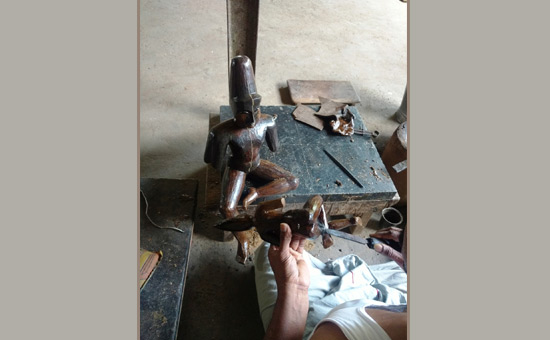 Rough outline in WAX.
Rough outline in WAX.
Sthapathy
manually makes a rough outline of the parts of the body of the icon in wax.
Details are worked on the rough outline with the help of WAX stick. Throughout
the process of model making, Sthapathy has to keep exposing the wax figure to a
source of heat since the wax tends to get hardened.
Wax
modelling as a step is a crucial one because the final form of the statue will
fully depend on the skill and visualization with which Sthapathy creates it. If
this stage is executed with sufficient care and concentration then the final
image emerges with great perfection saving Sthapathy all the time he may
otherwise spend in remodelling the metal image with hammer and chisel.
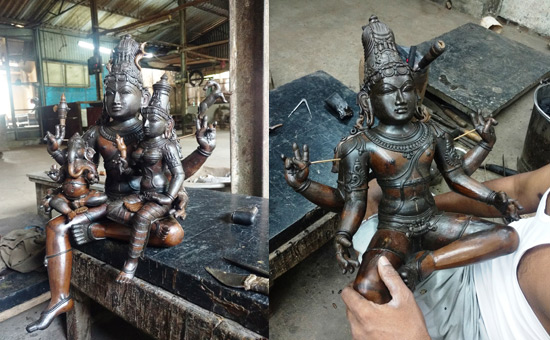
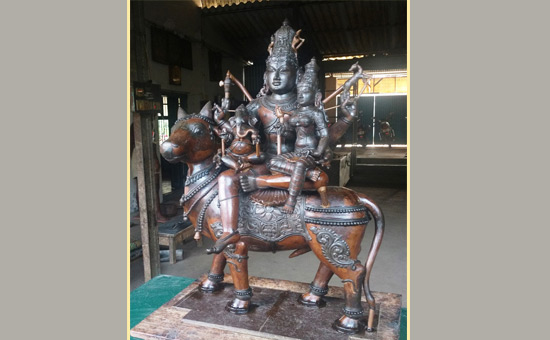 Wax work finishing stage.
Wax work finishing stage.
After
completing the wax model, it is mounted on a wax base which is in turn attached
to a wax rod in the shape of a funnel called the runner. This is to serve as an
outlet for the molten wax when the clay mould is heated for casting. The
Sthapathy also connects different sections of the image with wax rods to
facilitate easy running of molten metal alloy into all parts simultaneously.
Such rods also serve as additional support to the image when cast in metal
while Sthapathy works on the cast model with hammer and chisel to impart
finishing touches.
The
wax model is coated with finely ground clay in semi-solid paste and mixed with charred husk and cow-dung. The first
coating is applied in a semi solution from and allowed to dry before second
coat is applied. This process is repeated several times till a fine layer of
loom is spread out over the entire wax model surface. It is important that no portion
of the wax model escapes clay coating and its details are preserved exactly.
The
clay should be of fine texture to preserve the intricate details of the model
and strong enough to withstand the hot liquid metal pour. Clay from an anthill is preferred as an ideal
choice for this purpose.
The
model is then encased in several layers of coarser clay, each successive layer
becoming coarser and bulkier. Finally, a fine strip of steel or wire is tied
around the entire clay mould, while taking care that the wax orifice that shall
serve both as runner and vent while casting remains intact. When the clay mould
is dry and strong enough to withstand subsequent operations, heating the mould
over a drafted ground furnace clears the wax inside the mould. It melts and
runs out which is then collected and weighed in order to ascertain the quantity
of metal needed for casting.
The
composition of the metal used for casting is Copper, Zinc and Lead (the alloy
is called Bronze). In olden days small quantities of Silver and Gold were added
to make it Panchaloha/Panchadhatu (five metals). Zinc is added to reduce the
melting temperature of the alloy and also to give a golden hue to the finished
figure. Small quantity of lead is added just before casting to smoothen the
pouring and make the alloy flexible and soft for easy application of chisel and
hammer. So Copper as 84%, Zinc as 11 %, Lead as 4 %, reaming gold and Silver
used in micro quantity only for Sasthira.
Melting
of the alloy is done in ceramic crucibles. The furnace generally used for
melting is pit type, coke fuelled, with lining of fire clay brick and can
either be round or rectangular. A blower, manual or electric, is connected at
one end to blow air. Before actual casting the mould should be heated
sufficiently. A rough kiln is built around the mould and the fire is kept up by
burning firewood and dung cakes till the mould turns red hot. This hardens the
mould and expels traces of moisture.
The
mould is then buried in the earth up-to the mouth of the orifice to keep it
firm and upright in position while pouring molten metal into it.
It
also helps prevent premature and sudden cooling of the molten metal after
filling the empty chamber caused by removal of wax from the clay mould.
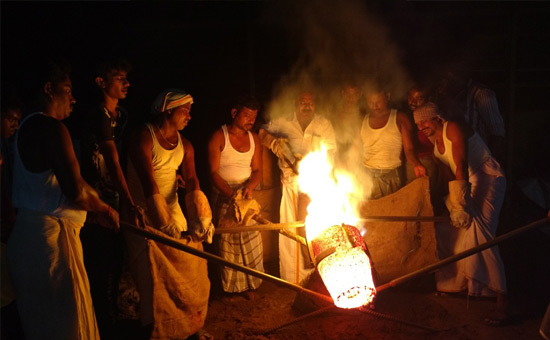 Pouring molten metal into the molds through the nails.
Pouring molten metal into the molds through the nails.
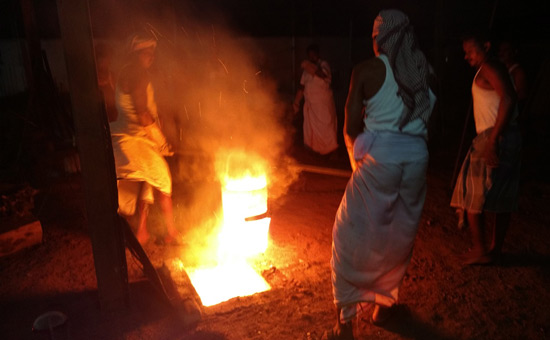 To melt the bronze a temperature of atleast 1800 F is needed for app 2-3 hours. After melting stage team take out the crucible & get ready for pouring.
To melt the bronze a temperature of atleast 1800 F is needed for app 2-3 hours. After melting stage team take out the crucible & get ready for pouring.
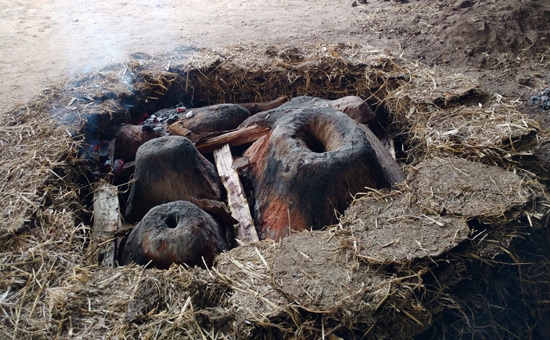 A rough kiln is built around the mould & the fire is kept up by burning firewood & cow dung cakes till the mould turns red hot.
A rough kiln is built around the mould & the fire is kept up by burning firewood & cow dung cakes till the mould turns red hot.
For
melting metal scraps are put into the crucible and melted to white heat in the
coke furnace. The crucible with accurately weighed metal scraps is put in the
furnace that is set alight. The air blower is turned on to help maintaining the
heat and flames. Metal scrap is added to the molten alloy in the crucible
periodically till the required quantity of metal is melted. When the metal has
reached proper temperature and the clay mould also heated sufficiently, pouring
(Casting) is done. Some protection in the form of rags etc. is spread around
the orifice at the time of pouring to prevent metal spilling. Metal is
generally poured in a thin stream. After the mould is completely filled with
molten metal it is left to cool.
Finally,
the cast piece is then recovered by digging out the mould, cutting the binding
strip or wire and breaking the clay layers. Sthapathy then proceeds on to the
next step of chiselling and shaping. For finishing hammers, chisels, files and Seevuli are used extensively and for
intricate work, finishing nails specially prepared by the Sthapathy himself are
used.
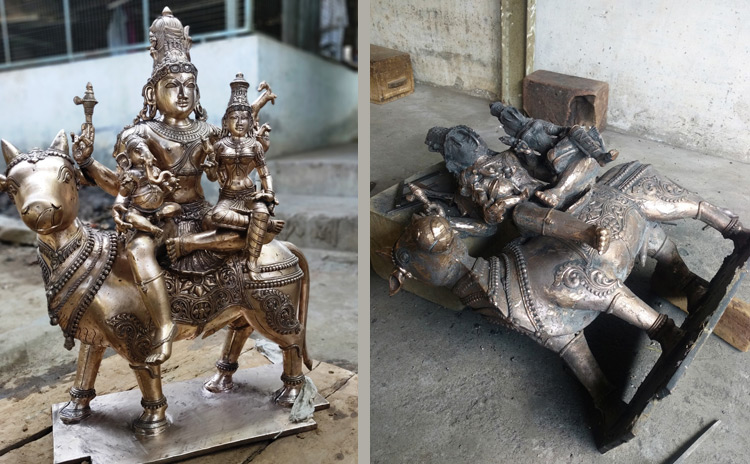
This
is the stage at which the Sthapathy employs his
skill in metal craft. He is the one who makes details in limbs, face,
ornaments, dresses, etc. emerge on the rough metal cast. The process of
polishing after finishing is quite laborious. It involves rubbing the surface
with fine grade emery paper, which makes it very smooth. The image is cleaned
in a solution of tamarind- water, polished
and finally washed with soap-nut by brushing briskly with the help of
wire-brush. This imparts a dazzling polish to the metal surface. The polished
figure could then be oxidized black or brown as required.
While
manufacturing traditional idols of gods that are used for worship in a Temple
or Home, finally the look will be in Golden polished finish. Similar contemporary
creations that are mostly used for display/decorative purposes will be in either
Brown antique finish look or wooden antique finish look/ Greenish antique look
colour. Choice is eventually of the user.
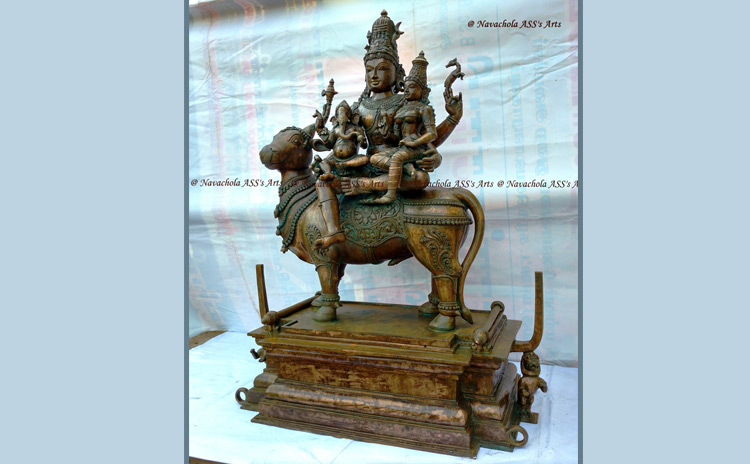
A
detailed figure about two to four feet that is intricately carved takes
anywhere between three to five months to complete. Moreover, the making of
these idols started on an auspicious day and time to ensure its successful completion!
The
most remarkable Religious
linkage of Chola Art now reproduced in a realistic way by TEAM Navachola. Founder is A S Sambandhamurthy, National
Merit Artisan.
Navachola
ASS Arts & Crafts (started 1984).
Renowned
Master Sculptor - South Indian traditional Bronze/Panchaloha Icon.
1/154
Konakarai, Swamimalai, Kumbakonam TK, Thanjavur DT,
Tamil
Nadu. India.
Contacts
- 91 9095121179 (whats app number), navachola@gmail.com
They
export to U.S., U.K., Canada, Germany, Sri Lanka, Malaysia and Singapore.
 2.5 feet Panchamuga Ganapathi-Urumbirai Karunakara Pillaiyar Temple, Jaffna, Sri Lanka.
2.5 feet Panchamuga Ganapathi-Urumbirai Karunakara Pillaiyar Temple, Jaffna, Sri Lanka.
 2 feet, Idumban Swamy, Sri Vadapathira Kaliyamman Temple, Singapore.
2 feet, Idumban Swamy, Sri Vadapathira Kaliyamman Temple, Singapore.
Social
Media
Facebook
Twitter
You Tube
Pinterest
Editor – At eSamskriti we believe in promoting Indian art forms. If artisans make money the tradition and knowledge will survive. If you decide to buy from Navachola please check and decide. eSamskriti does not assume responsibility for products sold by Navachola that you may buy after reading this article.
Also see albums of
1 Swamimalai
Bronze making
2 Temples
of Kumbakonam
3 Darasuram
Mandir Kumbakonam
4 Bastar Craft
5 Sudarshan
Arts and Crafts Village Bhubaneshwar